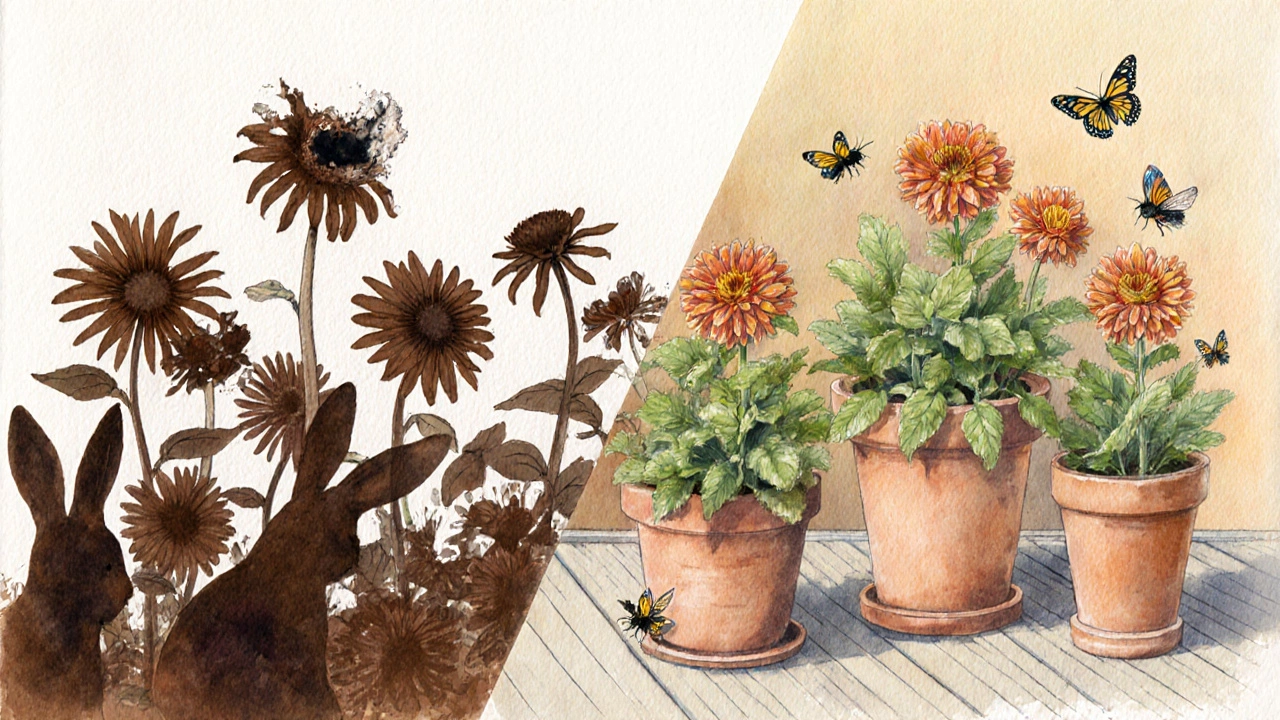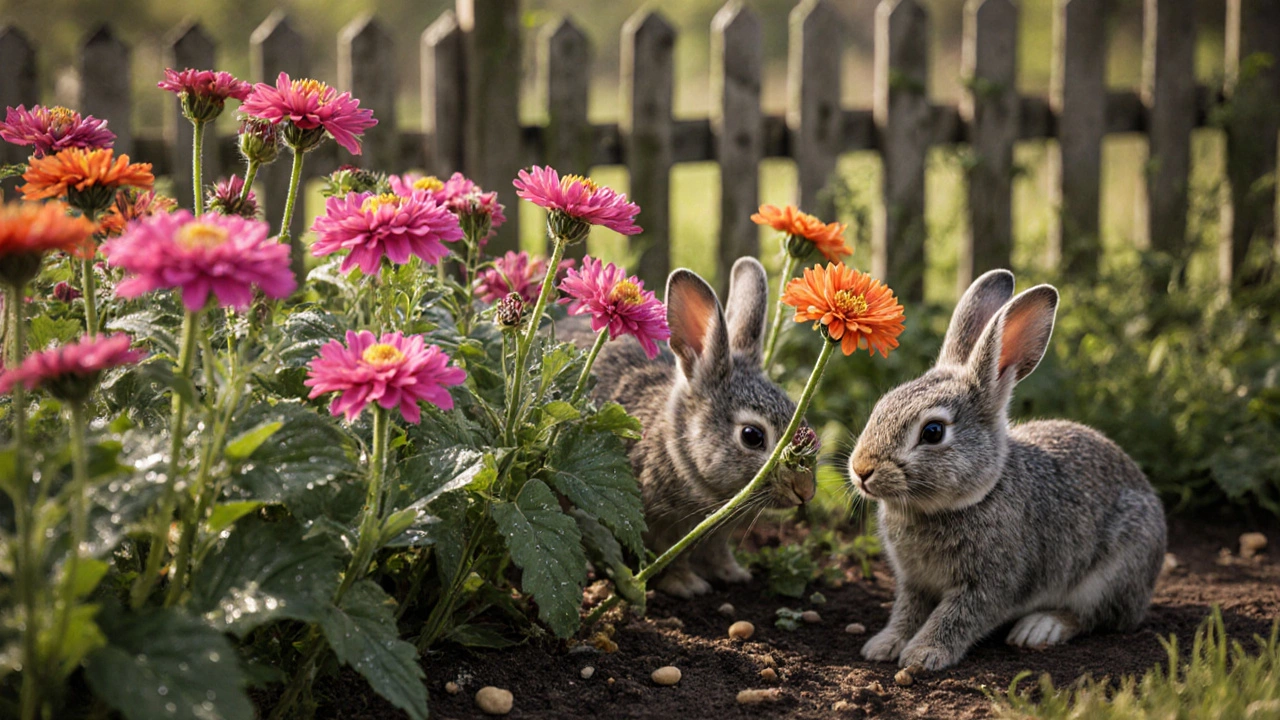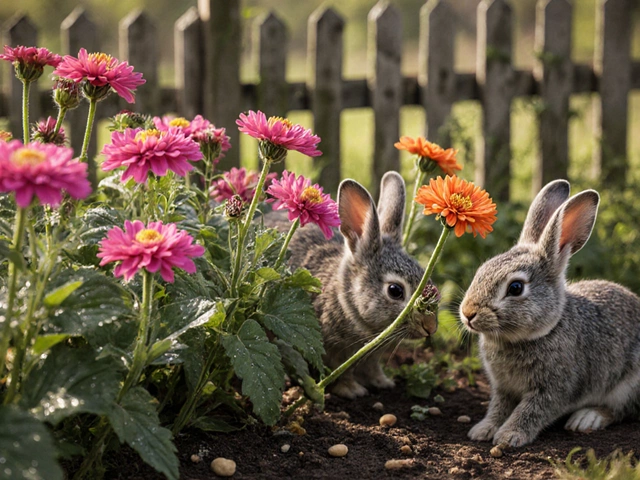Rabbit-Proof Zinnias Protection Calculator
Zinnia Protection Assessment
Tell us about your garden to get personalized rabbit protection recommendations for your zinnias.
Quick Tips
Your Recommended Protection Plan
Results will appear here after clicking the button.
If you’ve planted zinnias in your kitchen garden, you’re not alone. These bright, bold flowers bring color to vegetable beds, border paths, and even pots on the windowsill. But if you’ve spotted nibbled petals or chewed stems, you might be asking: Will rabbits eat zinnias? The short answer? Yes, they will - especially when food is scarce.
Why rabbits go for zinnias
Rabbits aren’t picky eaters when they’re hungry. They’ll munch on almost any green plant within reach, including flowers like zinnias. Zinnias have soft leaves and tender stems, which make them easy to chew. Unlike thorny or strongly scented plants, zinnias don’t have natural defenses. In early spring or late fall, when grasses and weeds are dry or gone, rabbits turn to garden flowers for moisture and nutrients.In Brighton, where I live, rabbit populations stay steady year-round. They’re especially active around dawn and dusk. If you’ve got a small kitchen garden near a fence line, hedge, or compost pile, you’re basically setting up a buffet.
Zinnias vs. other flowers: what rabbits prefer
Not all flowers are equally tasty to rabbits. Here’s what they usually go for first:- Marigolds (sometimes)
- Pansies
- Impatiens
- Zinnias
- Hostas
- Vegetable seedlings (lettuce, kale, beans)
They tend to avoid:
- Lavender
- Sage
- Marjoram
- Chives
- Daffodils
- Coreopsis
So while zinnias aren’t their top choice, they’re definitely on the menu. In fact, in a 2023 survey of 87 UK gardeners who lost flowers to rabbits, 41% reported zinnias as one of the top three damaged plants - right after lettuce and pansies.
How to tell if rabbits are the culprits
Before you panic and build a fence, make sure it’s actually rabbits. Here’s how to spot the signs:- Clean, angled bites - rabbits have sharp incisors that cut stems at a 45-degree angle, unlike snails or slugs that leave ragged edges.
- Low damage - rabbits can’t reach higher than 18 inches off the ground. If your zinnias are 2 feet tall and untouched, but the ones at ground level are gone, it’s rabbits.
- Small, round droppings - about the size of peas, scattered near the plants.
- Tracks - four-toed front prints and five-toed hind prints in soft soil.
Slugs leave slime trails. Deer leave torn, ripped leaves. Rabbits leave neat bites and tiny pellets. If you see that, you’ve got rabbits.

Protecting zinnias without fencing everything
You don’t need to turn your kitchen garden into a fortress. Here are five practical, low-cost ways to keep rabbits away from your zinnias:- Use chicken wire cages - Cut small cylinders of chicken wire (about 12 inches tall) and place them around each zinnia plant. Bury the bottom 2 inches in soil so rabbits can’t dig under. They’re cheap, easy to install, and you can reuse them every year.
- Plant zinnias near strong-smelling herbs - Put your zinnias next to rosemary, mint, or oregano. Rabbits avoid these scents. Even planting a row of chives between your flowers and the fence can help.
- Try natural repellents - Mix one egg, one tablespoon of hot sauce, and one quart of water. Spray it on the leaves (not the blooms) every 7-10 days, or after rain. It’s gross to humans, but rabbits hate it. Reapply often - it washes off.
- Use motion-activated sprinklers - A simple device like the Orbit 62100 turns on when it senses movement. Rabbits are startled by sudden water bursts. They learn to avoid the area after a few scares.
- Plant rabbit-resistant flowers nearby - Put coreopsis, salvia, or dusty miller around your zinnias. Rabbits will often nibble on those instead, leaving your zinnias alone.
What about commercial repellents?
There are plenty of sprays and granules sold as “rabbit-proof.” Some work - briefly. Most contain putrefied egg solids or blood meal. They smell bad to rabbits, but they also wash off in rain and lose potency in a few days. In my experience, they’re more expensive and less reliable than homemade sprays or physical barriers.One exception: products with capsaicin (the compound that makes chili peppers hot). These are longer-lasting and less smelly to humans. Look for brands labeled “organic” and “rain-resistant.” But even these aren’t 100% foolproof. Rabbits get desperate.
Can you grow zinnias in pots to avoid rabbits?
Yes - and it’s one of the smartest moves for kitchen gardeners with rabbit problems. Zinnias grow well in containers as long as they get full sun and good drainage. Use pots that are at least 12 inches deep and wide. Place them on a patio, balcony, or even a raised table. Rabbits can’t jump high enough to reach them.Plus, container gardening gives you more control over soil, watering, and spacing. You can even move the pots around if rabbits start lingering near your garden. In Brighton’s damp climate, pots dry out faster, so check soil daily. But the trade-off? Fewer rabbits, more color.

What to do if rabbits already damaged your zinnias
Don’t pull them out. Zinnias are resilient. If the stem is still intact and the plant has a few healthy leaves, it can recover. Cut off the chewed parts with clean shears. Water the base gently. New buds will often appear within 7-10 days.If the plant was eaten down to the soil, it’s gone. But zinnias grow fast - from seed to bloom in just 60 days. Sow new seeds in the same spot. They’ll catch up before the first frost.
Seasonal tips for rabbit-proofing your garden
Spring and fall are the worst times. That’s when natural food is thin. Here’s how to prepare:- Early spring: Install wire cages before your zinnias sprout. Don’t wait until they’re 6 inches tall - rabbits will have already found them.
- Summer: Keep your garden tidy. Remove tall grass or brush near the garden. Rabbits like cover.
- Autumn: Plant late-blooming zinnias in pots. Keep them off the ground. Rabbits are hungrier as winter approaches.
- Winter: Even in cold months, rabbits will nibble on dried stems. If you leave zinnia stalks for birds, cut them down to 4 inches - rabbits won’t bother with stubble.
Final thought: Zinnias are worth protecting
Zinnias are easy to grow, attract pollinators, and bloom nonstop from June until frost. They’re perfect for kitchen gardens because they’re cheerful, low-maintenance, and great for cutting. Losing them to rabbits is frustrating - but avoidable.Don’t let rabbits win. Combine a few simple strategies - cages, scent barriers, and smart placement - and you’ll enjoy your zinnias all season long. You don’t need to give up flowers to keep vegetables safe. With a little planning, your kitchen garden can be both productive and pretty.
Do rabbits eat zinnias in the UK?
Yes, rabbits in the UK do eat zinnias, especially in spring and fall when other plants are scarce. They’re common in gardens across England, including Brighton, and will nibble on zinnias if they’re within reach and no better options are available.
Are zinnias rabbit-resistant?
No, zinnias are not rabbit-resistant. They’re soft, juicy, and easy to chew - making them attractive to rabbits. Plants like lavender, sage, or daffodils are better choices if you want to avoid rabbit damage.
Will rabbits eat zinnia seeds?
Yes, rabbits will eat zinnia seeds if they find them on the soil surface. To protect seeds, cover them lightly with soil or use small wire mesh over the planting area until seedlings emerge.
Can I use coffee grounds to keep rabbits away?
Some gardeners swear by coffee grounds, but there’s no solid evidence they work reliably. Rabbits may avoid them briefly, but they quickly get used to the smell. They’re better for composting than repelling rabbits.
How high should a fence be to keep rabbits out?
A fence should be at least 2 feet (60 cm) high. Rabbits can jump, but not much higher than that. Bury the bottom 3-4 inches to prevent digging. Use 1-inch mesh hardware cloth - chicken wire can be too loose.
Do zinnias come back after rabbits eat them?
If the plant still has leaves and a healthy stem, yes - zinnias often regrow within a week or two. Cut damaged parts back, water well, and give them time. If the plant was eaten to the ground, it won’t return. But you can replant seeds - zinnias grow quickly.



